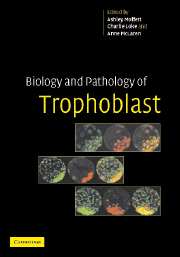Book contents
- Frontmatter
- Contents
- List of contributors
- List of participants
- Preface
- Chair's introduction
- 1 Trophoblast cell fate specification
- 2 Stem cells: pluripotency and extraembryonic differentiation in the mouse
- 3 Epigenetic regulation of trophoblast development
- 4 Regulation of X-chromosome inactivation in relation to lineage allocation in early mouse embryogenesis
- General discussion I
- 5 Gestational trophoblastic disease
- 6 Trophoblast and the first trimester environment
- 7 Implantation is a sticky situation
- 8 Trophoblast regulation of maternal endocrine function and behaviour
- General discussion II
- Final general discussion
- Index
- Plate section
- References
8 - Trophoblast regulation of maternal endocrine function and behaviour
from General discussion I
Published online by Cambridge University Press: 07 August 2009
- Frontmatter
- Contents
- List of contributors
- List of participants
- Preface
- Chair's introduction
- 1 Trophoblast cell fate specification
- 2 Stem cells: pluripotency and extraembryonic differentiation in the mouse
- 3 Epigenetic regulation of trophoblast development
- 4 Regulation of X-chromosome inactivation in relation to lineage allocation in early mouse embryogenesis
- General discussion I
- 5 Gestational trophoblastic disease
- 6 Trophoblast and the first trimester environment
- 7 Implantation is a sticky situation
- 8 Trophoblast regulation of maternal endocrine function and behaviour
- General discussion II
- Final general discussion
- Index
- Plate section
- References
Summary
Trophoblast cell lineage exerts considerable influence on maternal endocrine function. Progesterone is the steroid hormone that dominates pregnancy and is necessary to sustain pregnancy. The sustained production of progesterone beyond the normal duration of the oestrous cycle is common to all mammals and is referred to as the maternal recognition of pregnancy. However, the means of producing high levels of progesterone in maternal circulation varies according to species and the stage of pregnancy, and involves different cell types of the trophectoderm lineage. There are three important mechanisms for progesterone regulation by trophoblast cells (a) by direct synthesis, (b) indirectly by production of hormones that sustain the maternal corpus luteum (prolactin in rodents; chorionic gonadotrophins in primates and horses), and (c) indirectly by paracrine factors (antiluteolysins) that prevent uterine production of prostaglandins and luteal regression (sheep and cows trophoblast produce interferon).
The effects of progesterone on maternal tissues are mediated through its interaction with specific intracellular receptors that are members of the nuclear receptor superfamily of transcription factors (Tsai & O'Malley 1994). Progesterone receptor binding induces conformational changes in receptor structure leading to dimerisation, post-translational modification by recruitment of coactivator proteins and binding to specific enhancer DNA elements in promoters that initiate gene transcription. Progesterone has a broad spectrum of effects by acting on many maternal target tissues (Fig. 8.1).
Progesterone function in pregnancy
Implantation
A null mutation of the progesterone receptor in mice prevents decidualisation and pregnancy.
- Type
- Chapter
- Information
- Biology and Pathology of Trophoblast , pp. 148 - 168Publisher: Cambridge University PressPrint publication year: 2006
References
- 11
- Cited by



